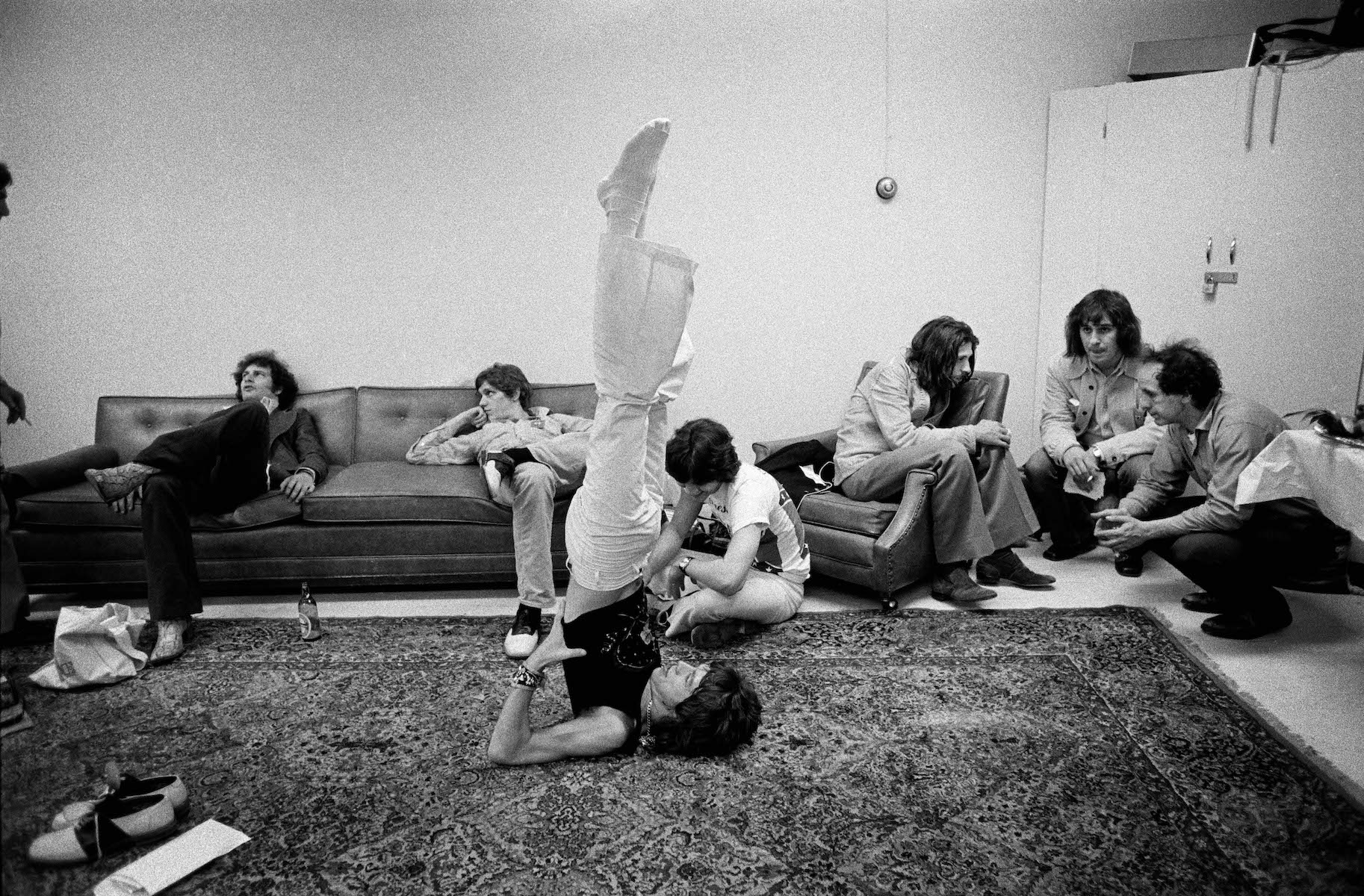Candid photos of the Rolling Stones on tour in 1972
- Text by Miss Rosen
- Photography by Jim Marshall Photography LLC

In 1972, the Rolling Stones had risen to new heights as the bad boys of rock ‘n roll. It was only fitting that their Exile on Main St. tour be documented by a photographer whose reputation matched their own – the legendary Jim Marshall (1936–2016).
“Jim had a reputation,” says Amelia Davis, Marshall’s longtime assistant and owner of the Jim Marshall Estate. Notorious for his love of cars, guns, and drugs – not to mention his take-no-prisoners attitude – Marshall had established himself as the leading music photographer of the times.

Richards, Jagger, Taylor.
After getting his start documenting the San Francisco jazz scene in the late 1950s, Marshall quickly became ensconced with the city’s burgeoning counterculture scene of the 1960s. His iconic photos of everyone from John Coltrane to Jimi Hendrix helped shape ideas about music when it was still a radical force for social change.
But, as Davis notes, more than anything else, Marshall considered himself a photojournalist. When LIFE magazine sent out word they were looking for an official photographer for the Stones tour, Marshall joined the throngs that submitted a portfolio of 10 images hoping for this plum assignment. “For Jim, to get the gig meant the world to him,” says Davis.
To celebrate the 50th anniversary of the historic tour, which became the subject of Robert Frank’s 1979 documentary film, Cocksucker Blues, the Jim Marshall Estate has just released The Rolling Stones 1972 (Chronicle).

Backstage at the Forum, Los Angeles, California. Due to logistics and security concerns, the Stones stayed at the venue between the afternoon and evening shows on June 11

Jagger stretches backstage. To his right, tour manager Peter Rudge huddles with assistant Danny Arnold and Robert Frank
Over the course of the tour, Marshall shot it all, providing an insider’s look at intimate moments in the studio, the banality of backstage, and feverish scenes of the Stones letting loose on stage. Never one to miss out on a good time, Marshall partied along.
“Jim did a shitload of cocaine,” says Davis. “One of the writers from LIFE complained [to the editors] that Jim was doing all this coke and they didn’t know what his photographs were going to look like. But of course, Jim’s photos were amazing. He was able to walk that line with the Stones.”
Although he had all-access, Marshall respected the people he photographed far too much to ever make incriminating or exploitative images that would pass as tabloid fodder. As a result, he earned the band’s trust; they knew they could be themselves without having to worry about being sold out.

Jolie Jones and Keith Richards on the plane back to Los Angeles

Mick Jagger and Keith Richards at Sunset Sound, the LA Recording Sessions, spring 1972
Marshall was far more interested in the Stones as musicians, artists, and men, creating portraits of Mick Jagger, Keith Edwards, Mick Taylor, Charlie Watts, and Bill Wyman that showed more than their bad boy personas.
“There were other photographers on the tour including Annie Leibowitz, Ethan Russell, and Ken Regan, but Jim was the only one to photograph quiet moments like Mick Jagger and Robert Frank on the plane,” says Davis. “Jim had all of these intimate moments among the chaos.”
Looking back at these images, Davis says, “It’s a bygone era. You don’t get that kind of access on stadium tours. You’re never going to see people leaning on the stages and interacting with the band again. It was such a different time.”

Mick Jagger at a publicity photo shoot, spring 1972, Los Angeles, California

LA Recording Sessions

Keith Richards backstage at the Forum, Los Angeles, California

Keith Richards

LARecording Sessions
The Rolling Stones 1972 is out now on Chronicle.
Enjoyed this article? Like Huck on Facebook or follow us on Twitter.
You might like

Analogue Appreciation: Joe Armon-Jones
All The Quiet (Part II) — In an ever more digital, online world, we ask our favourite artists about their most cherished pieces of physical culture. Today, it’s keyboardist, producer and Ezra Collective member Joe Armon-Jones.
Written by: Joe Armon-Jones

Largest-Ever Display of UK AIDS Memorial Quilt Opens at Tate Modern
Grief Made Visible — Comprising hundreds of panels made by lovers, friends and chosen family, the UK AIDS Memorial Quilt returns in full for the first time since 1994 – a testament to grief, friendship and the ongoing fight against HIV stigma.
Written by: Ella Glossop

Yaya Bey: “Capitalism is exploitation, period”
do it afraid — Ahead of the release of her second 18-track odyssey in just over a single year, we caught up with the prolific singer, discussing the pitfalls of the music industry, European ‘voyeurism’ framing her previous album and breaking narratives set upon her by others.
Written by: Isaac Muk

Remembering New York’s ’90s gay scene via its vibrant nightclub flyers
Getting In — After coming out in his 20s, David Kennerley became a fixture on the city’s queer scene, while pocketing invites that he picked up along the way. His latest book dives into his rich archive.
Written by: Miss Rosen

Nina Utashiro builds disquieting, macabre sonic worlds
Huck x Eastern Margins — We caught up with the Japanese-German rap experimentalist ahead of her performance at Huck’s SXSW London joint event with Eastern Margins.
Written by: Isaac Muk

We are all Mia Khalifa
How humour, therapy and community help Huck's latest cover star control her narrative.
Written by: Alya Mooro

